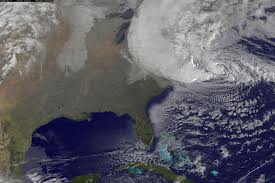
- It’s been a common reaction in the days after the hurricane, or post-tropical storm, or whatever we’re calling the 1,000 mile-wide wall of wind and rain that blasted the Northeast on Monday, to blame the shocking wave of destruction on global warming.
New York Gov. Andrew Cuomo chimed in early and often, offering Sandy as evidence “that climate change is reality.” Bloomberg Businessweek, ever a sucker for an arresting image, shouted “It’s Global Warming, Stupid,” from the cover of this week’s issue. New York City Mayor Michael Bloomberg took a more measured approach—”If this is a trend, it is simply not sustainable”—but nonetheless, invoked this week’s storm and underlined climate change in explaining his endorsement of President Barack Obama for reelection.
Meanwhile, estimates for the insured costs of the storm climbed as high as $20 billion, and we thought it would be worth hearing what the insurance industry had to say. After all, if the waters rise, the coastlines erode and changing weather patterns increase the frequency of tropical storms, insurance companies are going to incur large costs making good on property loss.
But when The Observer called the experts who build the sophisticated models that the insurance industry uses to assess risk, they told us that global warning wasn’t the first factor responsible for the damage caused by Sandy and other recent storms. Instead, it’s where we’ve built our homes.
“I don’t know that we have the historical track record to say that weather has become more volatile, but as a society we’ve become more vulnerable to weather risks,” said Megan Linkin, a hazard expert for reinsurer Swiss Re, told us over the telephone. “There are a lot of people who live in areas that are susceptible.”
“The big elephant in the room is not climate change,” Karen Clark, founder of Karen Clark & Co., and the creator of the modern catastrophe modeling industry, concurred. “It’s the increasing property values. We continue to build bigger, more expensive homes along the coast.”
That’s not to say that climate change doesn’t belong in the conversation on Sandy. Dr. Linkin’s employer, Swiss Re, is among the industry players attuned to the issue. When the New York City Panel on Climate Change published its final report in 2010, it included a chapter on insurance. (Among its recommendations: insurance pricing incentives for policyholders who rebuild homes to be more resilient to extreme weather.) Rather, that to focus on climate change in the aftermath to Sandy might be to miss the forest for the trees.
Ms. Clark was at the vanguard of the catastrophe modeling game when she founded Applied Insurance Research in 1987. In those days, the U.S. had gone decades without a hurricane landing, and insurance companies were grossly underestimating the risks involved. Ms. Clark’s models showed, for instance, that if a Category 5 hurricane hit Miami, the losses would have been on the order of $60 to $70 billion. “The insurance companies thought it was $7 billion,” she said. “They weren’t monitoring the trillions of dollars of property being built on the coastline.”
After Hurricane Andrew created about $21 billion in insured losses, the catastrophe modeling business took off. In addition to the independent catastrophe risk companies like the ones that Ms. Clark has founded, reinsurers—insurers for primary providers like State Farm or All State, basically—have built teams of meteorologists, seismologists, flood experts and engineers to model the hypothetical damage. To understand the expected cost of a storm, and ultimately, how much property owners should pay for insurance, the modelers map tens of thousands of storms over real-life physical data.
(For what it’s worth, Dr. Linkin told us that Swiss Re hadn’t built climate change into its model. “By including the most up to date information, if there is climate change present in the historical data, we’re including it,” she said.)
As Dr. Linkin pointed out, each of the hypothetical hurricanes in the catastrophe models is unique, though some more unusual than others. In the real world, storms are unique too. Certainly, much was made of Sandy’s mix of tropical weather with blocking weather patterns from the north and west.
But as a destructive force, Sandy is less unusual. The so-called Long Island Express, a 1938 hurricane that wrecked the Northeast, racked up $35 billion in insured damages in 2012 dollars, according to a paper Ms. Clark published in August, a good sight more than the current estimates for $10 to $20 million in insured costs for Sandy. A 1926 hurricane that leveled Miami caused insured costs of $126 billion by today’s dollars.
“Sandy was unprecedented, it’s a 500-year, 1000-year event, when they focus on the meteorology,” Ms. Clark said. “The impacts of Sandy are not unprecedented.” The way she tells it, we can expect more terribly destructive storms—not because of global warming, but because the concentration of population and property in harm’s way.

